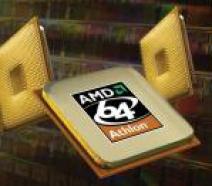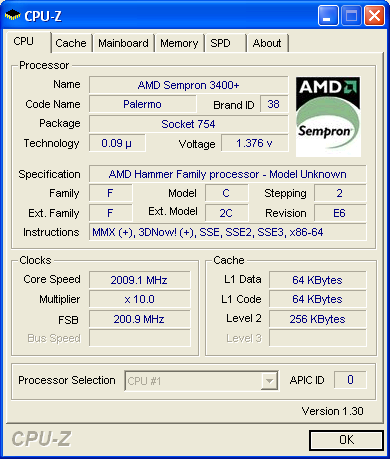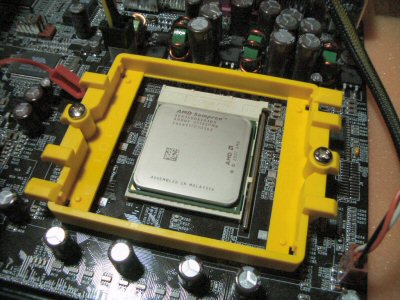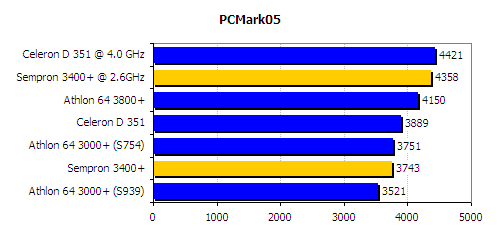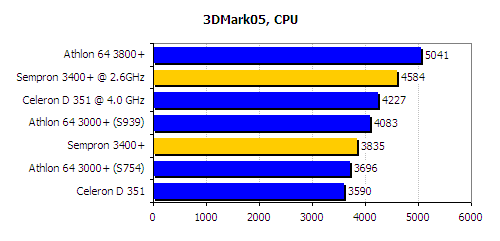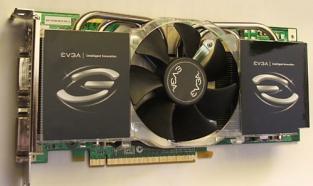AMD SEMPRON 3400+ CPU REVIEW BENCHMARK OVERCLOCKING
![]()
|
|
 |
||||||||||||||||||||||||||||||||||||||||||||||||
| Posted:2006-05-17 By hardware restoration Number of View:36120 |
|||||||||||||||||||||||||||||||||||||||||||||||||
By :hardware restoration Posted:2006-05-17
AMD Sempron 3400+ CPU Review benchmark overclocking
AMD is again expanding its value processor line, adding a new and faster model. Besides higher performance, the Sempron 3400+ brings in support of the AMD64 extensions and thus can effectively replace a junior Athlon 64. The x86-64 architecture is becoming ever more popular as processors that support the 64-bit AMD64 and EM64T technologies from AMD and Intel are widely available in the market and Windows XP, the number one operating system in this world, is officially available in its 64-bit version. The list of software titles that use the 64-bit modes is on the rise, too. In fact, if we put aside some unavoidable transition-related troubles like unrefined drivers or unresolved compatibility problems with some programs, there is only one thing inhibiting an all-out migration to x86-64. We mean the lack of low-end 64-bit systems. And this problem seems to be going to be solved soon, too. Not long ago Intel began to offer LGA775-packaged Celeron D processors with EM64T technology and then AMD followed suit, releasing Semprons with enabled AMD64. Thus, users with a limited budget can now enjoy the delights of those 64 bits, too. It doesn’t take much money anymore to build an x86-64 computer since junior CPU models with support of EM64T and AMD64 now cost a mere $60-70. Along with the introduction of its AMD64-supporting Semprons, AMD also revealed a new and faster CPU model in this series. The new processor with a recommended price of $134 has got a rating of 3400+ and we’ve received a sample of it in our labs. The Sempron 3400+ is based on an updated Palermo core (revision E6) . Since the x86-64 architecture is the main distinguishing feature of this product, we decided to test it in the 64-bit mode using Windows XP Professional x64 Edition. In other words, we’re going to see how today’s low-end processors perform in a 64-bit environment. AMD Sempron 3400+ ReviewBefore checking the new processor in tests, let us examine its characteristics and see how it differs from previous CPU models from AMD. Here’s the formal specification of this product:
As you can see, the Sempron family is moving ever closer to the Athlon 64 series. In fact, Athlon 64 processors only have a larger L2 cache but otherwise AMD’s value CPUs do not differ from them. Particularly, Semprons based on the E6 revision of the Palermo core not only support SSE3 instructions, the NX-bit and Cool’n’Quiet technology, but also boast support of the 64-bit AMD64 extensions. And this core may now also be used in junior models of the value series other than the new Sempron 3400+. Talking about similarities between the Sempron and Athlon 64 families, we shouldn’t forget, however, that senior Athlon 64 models work at higher frequencies and have a 1GHz HyperTransport bus and a dual-channel memory controller. Like its predecessors, the new Sempron 3400+ is intended for use in Socket 754 systems. AMD makes it clear that systems with a single-channel memory controller will still exist as low-end solutions. Even though AMD has long been shipping Socket 939 Semprons to its OEM partners, these are not available on the retail market yet. This policy is quite understandable: Socket 754 mainboards are cheaper and thus suit better as a foundation for an inexpensive computer. The Sempron 3400+ doesn’t differ much from the junior members of the family in its formal characteristics. For example, the Sempron 3400+ differs from the Sempron 3300+ in only one thing – it has a larger L2 cache (256 kilobyte). Yes, the new Sempron supports AMD64, but the new core may be used in the cheaper Semprons, too. Otherwise, the characteristics of these CPUs coincide, including electrical and thermal specs: the new processor dissipates up to 62 watts and consumes up to 40.6 amperes. The diagnostic utility CPUZ has the following to say about the Sempron 3400+:
The screenshot shows that CPUZ correctly identifies AMD64 technology provided by the revision E6 Palermo core as well as support of SSE3 instructions which appeared earlier, in the E3 revision. Note that other Sempron for Socket 754 models, with lower ratings, may have the same functionality. You can tell that a given Sempron is based on a core of the E6 revision and supports SSE3 and AMD64 by checking its marking. New low-end 64-bit processors have a marking that ends in the letters “BX”, like our sample of the Sempron 3400+.
Processors on the Palermo core of the E3 revision, i.e. without AMD64 technology, have a marking that ends in “BO”. This remark refers to models slower than the Sempron 3400+ since this model comes only on the new core and always supports the 64-bit extensions. Overclocking the amd 3400+People often buy Semprons to overclock them and lift their performance up to the level of much more expensive CPUs. So, we just couldn’t skip checking our Sempron 3400+ at higher frequencies. The Sempron 3400+ has a default clock rate of 2.0GHz, so its frequency multiplier is 10x. Because of Cool’n’Quiet technology, this multiplier can be decreased, but cannot be increased. The default multiplier is quite high, however, for the mainboard not to become a limiting factor at overclocking (we won’t have to heave the frequency of the clock generator up to values like 300MHz). Basing on our experience with other CPUs from AMD on the revision E core, we can expect the highest frequency of the Sempron 3400+ to be about 2.5-2.7GHz, so the mainboard must be stable at clock-generator frequencies of about 250-270MHz. By the way, these frequencies can be achieved even with more than one memory module (to get closer to a 300MHz clock-generator frequency, you usually have to use only one DIMM). We took a DFI LANPARTY UT nF3 250Gb mainboard for our overclocking experiments. This mainboard enjoys a reputation of one of the best platforms for Socket 754 processors. The system at large was assembled out of the following components:
We increased the CPU voltage to 1.5V to get higher results at overclocking. This is not a dangerous measure because the default voltage of the Sempron 3400+ is 1.4V. Some time ago we experimented with the Sempron 3100+ processor that was based on the E3 revision of the Palermo core . We achieved impressive results then, increasing the CPU frequency from the default 1.8GHz to 2.68GHz. This time, however, our revision E6 Sempron 3400+ couldn’t conquer the same clock rate, stopping at 2.6GHz.
The system was perfectly stable at this frequency performing such tests as S&M and Prime95. We don’t think it is a poor result, though. The CPU frequency gain was 30%, and the clock-generator frequency was 260MHz. We used a 5:4 divider to set the memory frequency at 216.5MHz
We must acknowledge the highest quality of Corsair’s CMX512-3200XL modules that worked at this frequency with the lowest timings possible (2-2-2-5). This should ensure an additional speed bonus to the overclocked system because, as you perhaps know, the integrated memory controller in K8 processors is exceptionally sensitive to the memory subsystem latency. Our overclocking results indicate that the frequency potential of the new Palermo core (stepping E6) with enabled AMD64 technology does not greatly differ from that of E3 stepping cores. In other words, overclockers who are into speeding up low-end processors can easily have a 64-bit computer using a new Sempron with enabled AMD64 Testbed and MethodsIt was an exciting thing to get a Sempron 3400+ into our hands. Even though we regularly examine processors of this class, the new product from AMD set two new problems before us. First, we had never had an opportunity to test low-end processors in the 64-bit mode. Second, we were curious to know how low-end 64-bit CPUs perform at overclocking. This review is an attempt to answer both these questions and that’s why we performed all the tests in Windows XP Professional x64 Edition which will surely become a widespread operating system soon. We took an Intel Celeron D 351 processor as the main opponent to the Sempron 3400+. This is the senior model from Intel’s value series and it supports Intel’s 64-bit EM64T extensions. This CPU works at 3.2GHz, uses a 533MHz system bus and has a 256KB L2 cache. This processor cost just a little less than the AMD Sempron 3400+, so we think it is correct to compare these two processors between each other. We also added the results of an overclocked Celeron D 351. Using air cooling and increasing the voltage of this CPU to 1.5V, we increased the frequency of our sample to 4GHz in our testbed, i.e. 25% above the default frequency. The FSB frequency grew up from 533 to 667MHz at that. To put the performance of the Sempron 3400+ at the default and overclocked frequencies in better perspective, we also publish the results of an Athlon 64 3000+ for Socket 754 (with a single-channel memory controller) and for Socket 939 (with a dual-channel memory controller) as well as of an Athlon 64 3800+ processor. So, here’s a full list of hardware parts we used in our tests:
We want to remind you once again that all tests from this review were done in Windows XP Professional x64 Edition, the new 64-bit operating system from Microsoft.
We tried to use native 64-bit benchmarks where possible. We will say in each particular case what processor mode each benchmark runs in. PerformanceWe’ll first compare the processors in FutureMark’s benchmarks. Pc mark 2005 benchmark
The new Sempron 3400+ is comparable to both Athlon 64 3000+ models but is slower than the competing Celeron D 351 in the overall performance score. The overclocked Sempron 3400+ becomes about 15% faster and beats the rather expensive Athlon 64 3800+. The overclocked Celeron D 351 is still on top, however. Pc mark 2005 benchmark cpu
The CPU test from the same benchmarking suite is favorable to the NetBurst architecture. As a result, the Celeron D 351 at the default frequency is faster even than the overclocked Sempron 3400+. As for the performance of the non-overclocked Sempron 3400+, it is better than either version of the Athlon 64 3000+. It may seem strange since the Athlon 64 3000+ for Socket 754 has the same frequency of 2GHz as the Sempron 3400+, but has a larger L2 cache (512 kilobytes). This mystery has an explanation, though. All Athlon 64 for Socket 754 are based on the older 130nm NewCastle core of the CG revision. The Sempron 3400+ features a new 90nm Palermo core of the E6 revision which has some advantages over the NewCastle. Particularly, the Palermo has an optimized memory controller and supports SSE3 instructions. These factors help the Sempron 3400+ triumph over the Athlon 64 3000+ in this test. Pc mark 2005 benchmark memory
The memory subsystem benchmark yields predictable results: the K8 processors with a dual-channel memory controller are better than their single-channel analogs, while the Celeron D only performs well when the system bus is overclocked. 3d 2005 benchmark
The CPU test from 3DMark05 puts the Sempron 3400+ on higher positions than the Celeron D 351 in the default mode as well as at overclocking. This is another confirmation of a highest efficiency of the K8 architecture in gaming applications. Note also that the Sempron 3400+ is faster here than the Athlon 64 3400+ for Socket 754. Despite AMD’s claims that there’s little difference between different cores, we can often see the Palermo win against the NewCastle even though the latter has a larger L2 cache Now let’s see how the new value processor from AMD performs in real games. far cry benchmark
First, we launched the recently released 64-bit version of Far Cry and the Sempron 3400+ ran it quite fast. Particularly, this CPU is ahead of the Celeron D 351 and is similar to the Athlon 64 3000+ models. When overclocked to 2.6GHz, the Sempron 3400+ is slightly slower than the Athlon 64 3800+ with has a 200MHz lower frequency, but a twice as large L2 cache and a dual-channel memory controller. doom 3 benchmark
It is all almost the same in the 32-bit Doom 3. The Celeron D is on the losing side again. Note that the amount of L2 cache memory is most important for Doom 3 , so the overclocked Sempron 3400+ is slower than the Athlon 64 3800+. half life benchmark
Another game shows us that the Celeron D has no chance against the Socket 754 Sempron in their competition for a place in an inexpensive gaming platform. Here, the Sempron 3400+ outperforms the Celeron D 351 by 38% in the regular mode and by 45% at overclocking. Now let’s measure the performance of AMD’s new value product at encoding audio and video. We took a 64-bit version of the LAME codec (it is beta version so far) to test the speed of encoding music into MP3 format. encoding benchmarklame benchmark:
The NetBurst architecture usually shows its strong points in encoding tasks, but this time the Sempron 3400+ is definitely better than the Celeron D 351. This is due to the 64-bit version of the LAME codec slowing down on Intel’s processors. xvid video encoding benchmark
It’s the same at encoding video with the 32-bit DivX 6.0 codec that has been optimized for the K8 architecture since the previous version. Besides that, Celeron D processors do not support Hyper-Threading technology which positively affects the speed of the NetBurst architecture in multi-threading applications. We should note that it is the CPU clock rate rather than the cache memory amount or the memory subsystem performance that determines the speed of a processor at encoding media data. That’s why the Sempron 3400+ wins these two tests when overclocked to 2.6GHz. To check the performance of the processors in professional applications and at final rendering, we use CINEBENCH 2003 which is also available in a native 64-bit
The Sempron 3400+ is faster than the Athlon 64 3000+ for Socket 939 (1.8GHz frequency) as well as the Socket 754 Athlon 64 3000+. The Celeron D 351 looks bad in this test – even at the overclocked frequency it cannot compete with the default-clocked Sempron 3400+. Conclusion of our reviewIt would be a stretch of the term “low-end” to apply it to the AMD Sempron 3400+ processor this article has been about. First, its price is rather high for a low-end solution, being $134. Second, this processor is not low-end in terms of performance, challenging junior models from the mainstream sector. As our tests have shown, the price of the Sempron 3400+ accurately matches its speed which is similar to Athlon 64 3000+ for Socket 754 and Socket 939 systems. As for functionality, the Sempron 3400+ only differs from Athlon 64 processors in having a smaller L2 cache (256 kilobytes). The rest of the features and technologies implemented in Athlon 64 series CPUs are all available in the new Sempron 3400+, too. On our part, we are pleased the most with the introduction of AMD64 technology in the value CPU family. Our comparative tests of the Sempron 3400+ and Intel’s Celeron 351 show that AMD’s value processor delivers more performance in a majority of applications, especially in games where the Sempron 3400+ is nearly 50% faster than the competing solution. Thus, we can state that the Sempron 3400+ is currently the best choice in its price category. Another nice thing about this product is its good overclockability. We managed to increase the clock rate of our sample to 2.6GHz. Working at this frequency, the Sempron 3400+ is just a little slower than the Athlon 64 3800+ which costs as much as $329. Considering the support of SSE3 and 64-bit extensions in the new processor, it has only one downside, namely its design for Socket 754. The Socket 939 platform looks a more appealing solution today since it offers more upgrade opportunities. On the other hand, the Socket 939 platform is approaching the end of its lifecycle, too, and processors for the M2 socket are going to become AMD’s flagship products in the next year.
we would be happy to answer for your question . if you have suggestion or comment
regarding this review our support would be glad to help just join our forum and ask u will get the best answer
to discuss check our forum section :-) RATE THIS REVIEW | |||||||||||||||||||||||||||||||||||||||||||||||||
![]()

AMD Sempron 3400+ CPU Review benchmark overclocking
AMD Sempron 3400+ CPU Review benchmark overclocking


7600gt review
7600gt is the middle card range.
We already benchmarked this video card and found that ...

 geforce 8800gtx and 8800gts
geforce 8800gtx and 8800gts  Xtreview software download Section
Xtreview software download Section  AMD TURION 64 X2 REVIEW
AMD TURION 64 X2 REVIEW  INTEL PENTIUM D 920 , INTEL PENTIUM D 930
INTEL PENTIUM D 920 , INTEL PENTIUM D 930  6800XT REVIEW
6800XT REVIEW  computer hardware REVIEW
computer hardware REVIEW  INTEL CONROE CORE DUO 2 REVIEW VS AMD AM2
INTEL CONROE CORE DUO 2 REVIEW VS AMD AM2  INTEL PENTIUM D 805 INTEL D805
INTEL PENTIUM D 805 INTEL D805  Free desktop wallpaper
Free desktop wallpaper  online fighting game
online fighting game  Xtreview price comparison center
Xtreview price comparison center 

- The new version of GPU-Z finally kills the belief in the miracle of Vega transformation
- The motherboard manufacturer confirms the characteristics of the processors Coffee Lake
- We are looking for copper coolers on NVIDIA Volta computing accelerators
- Unofficially about Intels plans to release 300-series chipset
- The Japanese representation of AMD offered monetary compensation to the first buyers of Ryzen Threadripper
- This year will not be released more than 45 million motherboards
- TSMC denies the presentation of charges from the antimonopoly authorities
- Radeon RX Vega 64 at frequencies 1802-1000 MHz updated the record GPUPI 1B
- AMD itself would like to believe that mobile processors Ryzen have already been released
- AMD Vega 20 will find application in accelerating computations
- Pre-orders for new iPhone start next week
- Radeon RX Vega 57, 58 and 59: the wonders of transformation
- ASML starts commercial delivery of EUV-scanners
- The older Skylake processors with a free multiplier are removed from production
- Meizu will release Android-smartphone based on Helio P40
- AMD Bristol Ridge processors are also available in American retail
- The fate of Toshiba Memory can be solved to the next environment
- duo GeForce GTX 1080 Ti in GPUPI 1B at frequencies of 2480-10320 MHz
- New Kentsfield overclocking record up to 5204 MHz
- Lenovo released Android-smartphone K8



computer news computer parts review Old Forum Downloads New Forum Login Join Articles terms Hardware blog Sitemap Get Freebies
